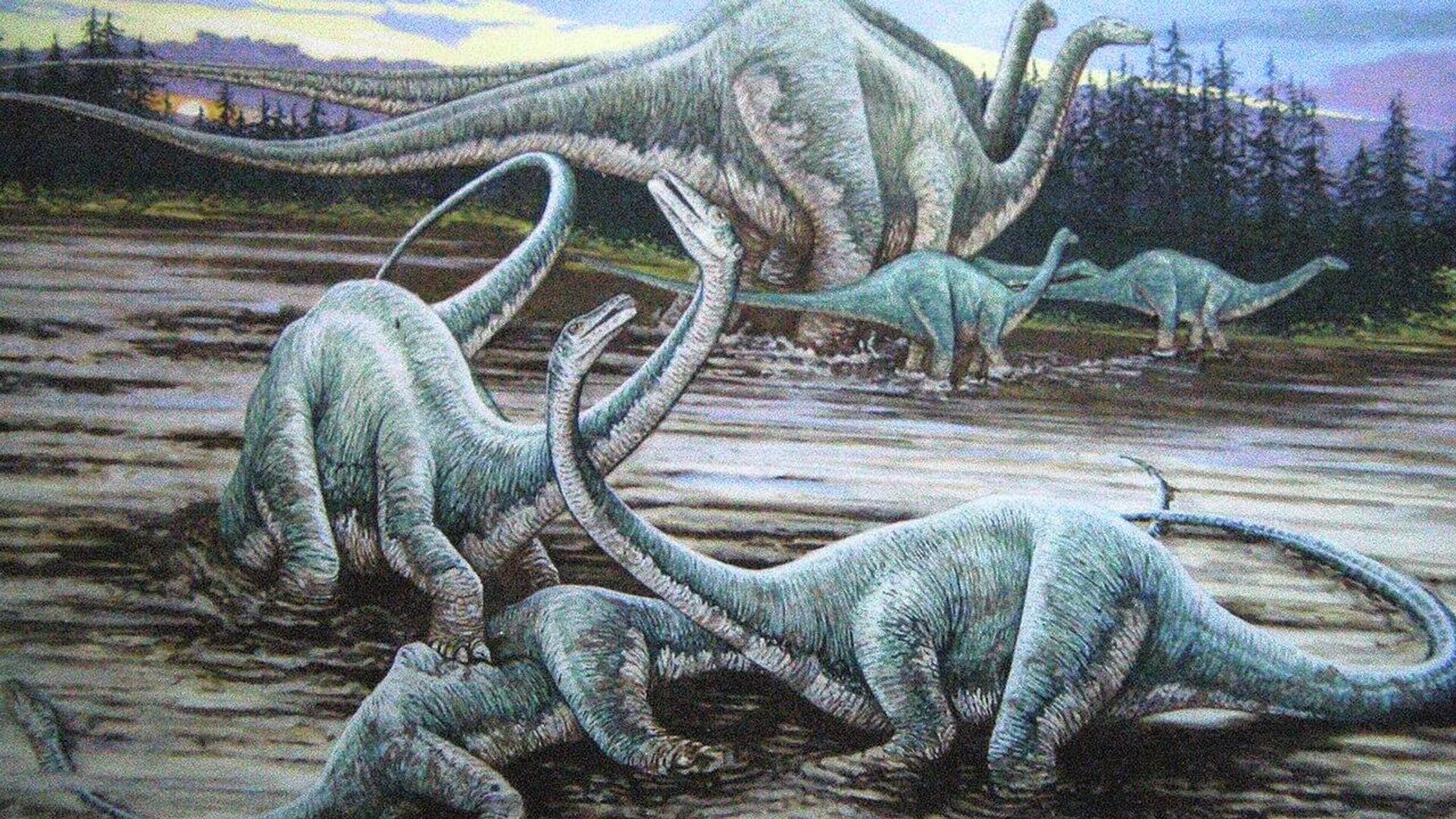https://sputnikglobe.com/20230703/bird-like-air-spaces-in-dinosaurs-bones-key-to-their-gigantic-size-1111641433.html
Bird-Like Air Spaces in Dinosaurs' Bones Key to Their Gigantic Size
Bird-Like Air Spaces in Dinosaurs' Bones Key to Their Gigantic Size
Sputnik International
Palaeontologists in Brazil studying one of the earliest-known dinosaurs have found its backbone contained large air spaces found in the most gigantic species, which lightened their massive necks and helped them breathe.
2023-07-03T17:14+0000
2023-07-03T17:14+0000
2023-07-03T17:14+0000
world
dinosaurs
brazil
https://cdn1.img.sputnikglobe.com/img/07e6/07/16/1097700055_0:0:1280:720_1920x0_80_0_0_a436e8fddc3cd6619e9d40f5cbb08b05.jpg
Brazilian fossil-hunters have discovered that one of the oldest dinosaurs had evolved a crucial feature that allowed its successors to grow to enormous size.Macrocollum itaquii first appears in the fossil record around 225 million years ago, less than 10 million years later than the oldest-known dinosaur remains but long before the dinosaurs became the dominant order of animals after the Triassic-Jurassic extinction event around 201 million years before now.The bipedal, herbivorous Macrocollum, named for its long neck topped with a small head, belonged to the Sauropodomorph group, ancestors of the Sauropods which include the most enormous land animals that ever lived — including Brachiosaurus and recently-discovered giants like Supersaurus and Patagotitan.Now palaeontologists at the State University of Campinas (UNICAMP) in Brazil's Sao Paulo State have found the species shared a key adaptive feature with its gigantic descendants: sinuses in its vertebrae that lightened the bones and help with respiration.Although small by the standards of the monstrous species that evolved later, the three-metre-long beast was the king of the dinosaurs in its day. The species takes the second part of its name from Brazilian palaeontologist José Jerundino Machado Itaqui, a founder of the South American nation's CAPPA/UFSM study centre.The team said the spaces they found were pneumatic chambers with a previously-unknown pattern of tissue which the termed "protocamerate" — meaning "chamber-like".The later Therapod dinosaurs, which include Tyrannosaurus rex and other gigantic predators, had more extensive hollowing of the bones — which allowed their descendants - the birds - to achieve flight.
https://sputnikglobe.com/20230616/siberian-scientists-unearth-bone-belonging-to-massive-sauropod-dinosaur-1111213904.html
brazil
Sputnik International
feedback@sputniknews.com
+74956456601
MIA „Rossiya Segodnya“
2023
James Tweedie
https://cdn1.img.sputnikglobe.com/img/07e4/08/1c/1080307270_0:3:397:400_100x100_80_0_0_7777393b9b18802f2e3c5eaa9cbcc612.png
James Tweedie
https://cdn1.img.sputnikglobe.com/img/07e4/08/1c/1080307270_0:3:397:400_100x100_80_0_0_7777393b9b18802f2e3c5eaa9cbcc612.png
News
en_EN
Sputnik International
feedback@sputniknews.com
+74956456601
MIA „Rossiya Segodnya“
Sputnik International
feedback@sputniknews.com
+74956456601
MIA „Rossiya Segodnya“
James Tweedie
https://cdn1.img.sputnikglobe.com/img/07e4/08/1c/1080307270_0:3:397:400_100x100_80_0_0_7777393b9b18802f2e3c5eaa9cbcc612.png
brazilian palaeontologists discover evolutionary origin of hollow vertebrae in giant sauropod dinosaurs, how did dinosaurs evolve to grow so big?
brazilian palaeontologists discover evolutionary origin of hollow vertebrae in giant sauropod dinosaurs, how did dinosaurs evolve to grow so big?
Bird-Like Air Spaces in Dinosaurs' Bones Key to Their Gigantic Size
Palaeontologists in Brazil studying one of the earliest-known dinosaurs have found its backbone contained large air spaces found in the most gigantic species such as Diplodocus and Brontosaurus, which lightened their massive necks and helped them breathe.
Brazilian fossil-hunters have discovered that one of the oldest
dinosaurs had evolved a crucial feature that allowed its successors to grow to enormous size.
Macrocollum itaquii first appears in the fossil record around 225 million years ago, less than 10 million years later than the oldest-known dinosaur remains but long before the dinosaurs became the dominant order of animals after the Triassic-Jurassic
extinction event around 201 million years before now.
The bipedal, herbivorous Macrocollum, named for its long neck topped with a small head, belonged to the Sauropodomorph group, ancestors of the Sauropods which include the most enormous land animals that ever lived — including Brachiosaurus and recently-discovered giants like Supersaurus and Patagotitan.
Now palaeontologists at the State University of Campinas (UNICAMP) in Brazil's Sao Paulo State have found the species shared a key adaptive feature with its gigantic descendants: sinuses in its vertebrae that lightened the bones and help with respiration.
“Air sacs made their bones less dense, allowing them to grow to more than 30 m [100 feet] in length,” said Dr Tito Aureliano.
Although small by the standards of the monstrous species that evolved later, the three-metre-long beast was the king of the dinosaurs in its day.
“Macrocollum itaquii was the largest dinosaur of its time, with a length of about three metres [10 feet],” Aureliano noted. “A few million years before then, the largest dinosaurs were about one metre [three feet three inches] long. Air sacs certainly facilitated this increase in size.”
The species takes the second part of its name from Brazilian palaeontologist José Jerundino Machado Itaqui, a founder of the South American nation's CAPPA/UFSM study centre.
The team said the spaces they found were pneumatic chambers with a previously-unknown pattern of tissue which the termed "protocamerate" — meaning "chamber-like".
"It seems that evolution experimented with different forms until it arrived at the definitive system, where air sacs spanned from the cervical region to the tail. It was not a linear process," Aureliano said.
The later Therapod dinosaurs, which include Tyrannosaurus rex and other gigantic predators, had more extensive hollowing of the bones — which allowed their
descendants - the birds - to achieve flight.




